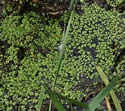Lemna minor (Common Duckweed)
| Also known as: | Lesser Duckweed |
|---|---|
| Genus: | Lemna |
| Family: | Araceae (Arum) |
| Life cycle: | perennial |
| Origin: | native |
| Habitat: | part shade, shade, sun; quiet, shallow water; lakes, ponds, pools, river bottoms, slow-moving streams, marshes |
| Bloom season: | August |
| Plant height: | 1 to 2 millimeters |
| Wetland Indicator Status: | GP: OBL MW: OBL NCNE: OBL |
| MN county distribution (click map to enlarge): |  |
| National distribution (click map to enlarge): |  |
Pick an image for a larger view. See the glossary for icon descriptions.
Detailed Information
Flower:
Plants rarely flower. Flowers are contained in lateral pouches near the base of the plant with a narrow opening at the top, usually 1 flower per plant, occasionally 2. Flowers lack petals or sepals, have 2 stamens and a single style.
Leaves and stems: 
![[photo of leaves]](/udata/r9ndp23q/aquatic/lemna-minor-20221009-s1-t.jpg) Leaves, known as fronds, float on the water's surface, are 1 to 8 mm (to ~1/3 inch) long, 1 to 2 times as long as wide, oval to inversely egg-shaped, widest at or above the middle, rounded at the tip, lack a stem and are faintly 3-veined. The upper frond surface is bright green and more or less flat. Sometimes 1 or more minute bumps (papillae) are present along the midvein but these are mostly obscure. The lower surface is typically green, seldom slightly tinged red or purple. Attached towards the base of a frond is a single root up to 6 inches (15 cm) long, but usually much shorter. A plant has a single frond; 2 to several are often connected together though may eventually separate.
Leaves, known as fronds, float on the water's surface, are 1 to 8 mm (to ~1/3 inch) long, 1 to 2 times as long as wide, oval to inversely egg-shaped, widest at or above the middle, rounded at the tip, lack a stem and are faintly 3-veined. The upper frond surface is bright green and more or less flat. Sometimes 1 or more minute bumps (papillae) are present along the midvein but these are mostly obscure. The lower surface is typically green, seldom slightly tinged red or purple. Attached towards the base of a frond is a single root up to 6 inches (15 cm) long, but usually much shorter. A plant has a single frond; 2 to several are often connected together though may eventually separate.
Fruit: 
Like the rare flower, fruit—a tiny, ribbed seed—is rarely produced. Reproduction is primarily vegetative, new fronds emerging from the side pouch, developing a root, and may eventually break away.
Notes:
Common Duckweed is found in the quiet waters of lakes, ponds, marshes, swamps, swales, sloughs and slow-moving streams. It's frequently mixed with Watermeals (Wolffia) and other Duckweeds (Lemna and Spirodela), forming large colonies that can cover the entire surface of a pond. It is typically identified by the upper surface of the frond being more or less smooth and flat, lacking distinct raised bumps along the midvein, and the lack of turions (rootless offshoots produced in late summer that break off and overwinter).
Lemna minor is most easily confused with Lemna turionifera, which can be somewhat smaller (fronds up to 4 mm long) and typically has distinct raised bumps on the midvein as well as turions, but it can be very difficult to distinguish them when turions are absent. Anita Cholewa, a curator at the Bell Herbarium (now retired) noted that most of the L. minor specimens were previously misidentified and are L. turionifera instead. The county distribution map shows that discrepancy, with fewer than 20 counties having L. minor per the DNR's MNTaxa and biological survey records, but herbarium records in nearly every county. Correcting the records could be particularly challenging since dried specimens tend to be extremely difficult to distinguish.
Native Plant Nurseries, Restoration and Landscaping Services ↓
More photos
Photos by K. Chayka taken in Scott County.
Comments
Have you seen this plant in Minnesota, or have any other comments about it?







 Common Duckweed plants
Common Duckweed plants Common Duckweed stuck in the muck
Common Duckweed stuck in the muck Common Duckweed in a pond
Common Duckweed in a pond